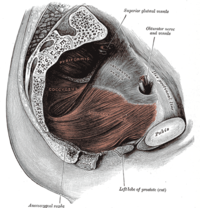Pubococcygeus muscle
| Pubococcygeus muscle |
|---|

|
| origin |
| Pubic bone |
| approach |
| coccyx |
| function |
| Part of the levator ani muscle |
| Innervation |
| Sacral plexus |
| Spinal segments |
| S3-S5 |
The pubococcygeus muscle ( Latin for "pubic bone-coccyx muscle", pronounced pubokogzygäus ) - also PC for short - is one of the muscles that surround the male and female genital organs in the pelvic floor area. It is part of the levator ani muscle . Its position is easy to identify because it is the muscle that can be used to stop urination. In women it can also be felt vaginally .
anatomy
The muscle arises on the body of the pubic bone ( corpus ossis pubis ) and runs to the coccyx . Based on the positional relationships to the pelvic organs, the muscle is further subdivided into:
- Musculus puboprostaticus ("pubic bone-prostate muscle"; synonym Musculus levator prostatae ) or Musculus pubovaginalis ("pubic bone-vaginal muscle") as well as the in both sexes
- Puboanalis muscle .
Training of the pubococcygeus muscle
The muscle works according to both reflex ( autonomic nervous system ) and voluntary ( somatic nervous system ) control. Therefore it can be trained like any other arbitrarily controllable muscle. Exercising the pc can help increase sexual intensity and is also an effective remedy for fecal incontinence .
In many newer gymnastic approaches (such as Callanetics ), training the PC muscle is of great importance. It is also very important in Tantrism and Daoist sexual practices . The tensing of the muscle can allegedly lead to a voluntary control of the normally involuntary prostate contractions and enable what is known as injection . With extensive mastery of the PC muscle, it should also be possible for the man to delay or prevent an ejaculation .

literature
- L. Richard Drake, Wayne Vogl, Adam WM Mitchell: Gray's Anatomy for Students . Elsevier, Urban & Fischer, 2007, ISBN 978-3-437-41231-8 , pp. 404 .
- Heike Höfler, Ulli Seer: Pelvic floor exercises: 140 exercises for him and her . blv, Munich 2005, ISBN 3-405-16922-4 (contains exercises for men and women).
- Margo Anand : Tantra or the Art of Sexual Ecstasy . Goldmann, Munich 2000, ISBN 3-442-13847-7 (English: The art of sexual ecstasy . Translated by Karin Petersen, contains practical instructions for using the PC muscle).